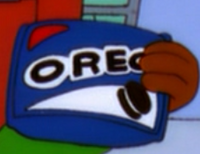
Difference between revisions of "Oreo"
Wikisimpsons - The Simpsons Wiki
Solar Dragon (talk | contribs) m |
|||
| Line 5: | Line 5: | ||
|type = Cookie | |type = Cookie | ||
|town = | |town = | ||
| − | |appearance = "[[ | + | |appearance = "[[The Cartridge Family]]" |
}} | }} | ||
| Line 26: | Line 26: | ||
== Appearances == | == Appearances == | ||
| + | *{{ep|The Cartridge Family}} | ||
*{{ep|Helter Shelter}} | *{{ep|Helter Shelter}} | ||
*{{ep|Fat Man and Little Boy|(mentioned on T-shirt)}} | *{{ep|Fat Man and Little Boy|(mentioned on T-shirt)}} | ||
Revision as of 13:22, February 11, 2022
Oreo
| ||||
Food/Drink Information
|
An Oreo is a type of sandwich cookie. It consists of two round wafer-like cookies with a layer of frosting in the middle.
History
When the Simpson family were on the reality TV show The 1895 Challenge, they visited the Kwik-E-Mart. Marge wanted to buy a package of Oreos, but Apu didn't allow her to as the cookies were from 1896.[1]
Toot-Toot gave Bart an Oreo which he ate because it was "rank".[2]
Homer is eating Mega Stuff, a cheap version of Oreo.[3]
Non-canon

|
The contents of this article or section are considered to be non-canon and therefore may not have actually happened or existed. |
Fat Tony had crushed Oreo on his yogurt from Takin' Care of Business Yogurt.[4]
Behind the Laughter
- Oreo is a real product.
- Oreos were actually introduced in 1912, not 1896 as Apu implies.
Appearances
 Episode – "The Cartridge Family"
Episode – "The Cartridge Family"  Episode – "Helter Shelter"
Episode – "Helter Shelter"  Episode – "Fat Man and Little Boy" (mentioned on T-shirt)
Episode – "Fat Man and Little Boy" (mentioned on T-shirt) Episode – "Bart Has Two Mommies"
Episode – "Bart Has Two Mommies"  Episode – "The Great Phatsby: Part One"
Episode – "The Great Phatsby: Part One"  THOH – "Treehouse of Horror XXIX" (opening scene; grave)
THOH – "Treehouse of Horror XXIX" (opening scene; grave) Episode – "Todd, Todd, Why Hast Thou Forsaken Me?"
Episode – "Todd, Todd, Why Hast Thou Forsaken Me?"  Episode – "Uncut Femmes"
Episode – "Uncut Femmes"

